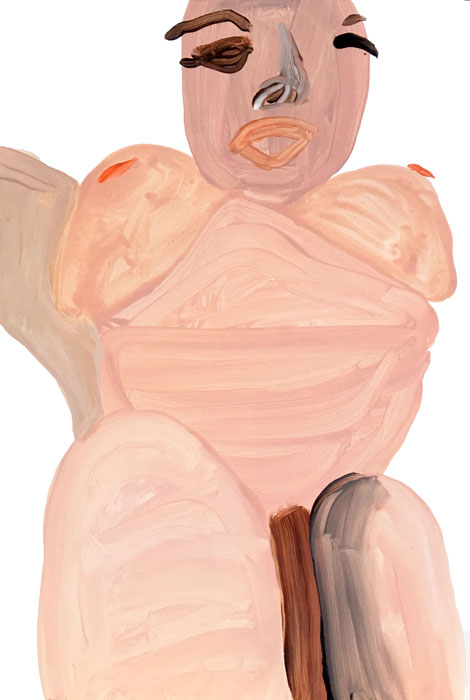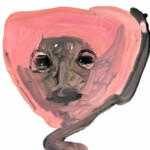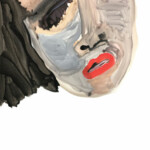Exhibition
in Zürich / Switzerland
- Megan Rooney: Old Baggy Root, 2019, (detail), acrylic, ink and pencil on paper, 76 x 56 cm
- Megan Rooney: Old Baggy Root, 2019, (detail), acrylic, ink and pencil on paper, 76 x 56 cm
- Megan Rooney: Old Baggy Root, 2019, (detail), acrylic, ink and pencil on paper, 76 x 56 cm
- Megan Rooney: Old Baggy Root, 2019, (detail), acrylic, ink and pencil on paper, 76 x 56 cm
This exhibition looks at the potential of the fragmented body: fluid boundaries and vulnerabilities expressed through the medium of mural painting, trompe-l’œil and sculpture. Fragmentation, experienced here both in formal and abstract articulations, makes palpable the somatic and emotional potential of the body. Recalling Lacan’s notion of the fragmented body when viewing the show, one is potentially able to experience the self as an imaginative creation, not constituted as an atomic individual but rather as a liminal space between language and society mediated by one’s own body.
Be it within the context of aesthetic theory with Adorno’s focus on the fragment’s potential to magnify and resist wholeness or the postmodernist idea in which the fragment is considered an opportunity for plurality, the discourse around the fragment and its latent symbolic rhetoric has been widely adopted and articulated in many artistic and cultural spheres. John Cage’s open-ended approach to music composition, Dieter Roth and John M. Bennett’s concrete poetry, Samuel Beckett and Eugene Ionesco’s “Theater of the Absurd”, Pina Bausch and her introspective dance compositions, Cy Twombly and his freely-scribbled, calligraphic paintings or even the writings of second and third wave feminist thinkers such as Judith Butler, Carla Lonzi and Adriana Cavarero are just few examples of the fragment in use as a creative tool.
Megan Rooney (b. 1985) is an enigmatic storyteller. Her practice unfolds across painting and murals, writings, spoken word performance, sculpture and installation. Her narratives and characters start from a restless looking at people in public space. Inspired by the city and its social fabric she observes the invisible boundaries and distances between people. Her vast, improvised, rawly painted and colour-drenched paintings often contain hazy human figures lurking, seducing the viewer to get closer and incite “something that might make you feel a bit funny in your teeth four days later.”* It’s a deviating and shifting play with the audience. Much like in poetry, Rooney uses devices such as repetition and symbolism that take shape as unidentifiable splotches, linear and anthropomorphic forms, naïve-looking mushy faces. They convey an usease. Rooney notes: “I think about marks and destruction and reducing forms and faces hiding inside smears. Flesh that’s dripping, sagging, bleeding and wet. Contorted bodies laying in bed at night.”**
Sarah Margnetti (b.1983) is known for her mastery of trompe l’œil. It is a technique she acquired after her studies at the Institut Supérieur de Peinture Van der Kelen-Logelain in Brussel, one of the few schools in the world still teaching traditional techniques of decorative painting. The replication of wood and marble as in Venetian frescoes have become an integral part of her practice and frequently incorporate fragmented body parts suspended in midair. At first sight these monumental caricature-like extremities have a humorous appeal. Sometimes only partly visible behind curtains or pillars, the figures reveal a concern with the commodification of the body, a questioning of the symbolic power of various body parts, but also relates to a discourse on gaze, sex and gender.
Rooney and Margnetti break up the unity of the body. We see this in Rooney’s works on paper and her white-primed canvas with hovering body parts in a backdrop of washed tones of purples, blues and rose-madder reds. Margnetti’s enlarged yellow noses and ears, and her trompe-l’œil of marble and wood also extract the body from context and suggest a new subjectivity. Their idiosyncratic visual languages open up the discussion on the fragment as a vehicle of resistance. Many are the artists who historically have embraced this ambiguity and have influenced a generation of artists, mainly female, who have taken up the challenge to disrupt unity as a subtle and yet structural resistance to the status quo.
One of these references is Carol Rama and her treatment of the body. A self-taught Italian artist, Rama dealt with themes of sexuality and bodily forms in a deep desire to release inner anguish. “I paint out of passion, anger, violence, sadness, a certain fetishism, out of joy and melancholy together, but out of anger especially,” she once explained.*** Rooney’s raw and candid portraits of sensuous faces, limbs, breasts and nipples echoes Rama’s watercolors ability to unmask taboos around sex, pain, love and mental health. The fetishistic vitality of these works recall Margnetti’s vocabulary of the body.
A similar liking to the appropriation of body parts as a fetish totemic element can be found in Sarah Lucas’s obsession with protuberances, be they male genitalia either disguised as vegetables, meat, fish or beer cans or exposed realistically in deluxe materials like brass and solid gold or her grotesque headless female figures draped seductively on chairs. Margnetti also flexes body parts with both humor and urgency compelled by a dry and caustic ambiguity, one that seems to question the imperfection and absurdity of the human condition.
Louise Bourgeois and her monumental spiders, eerie “Cells,” evocative hanging figures and fabric works is a further example of a highly personal visual language which has used mythological and archetypal imagery as a tool to address issues like the feminine psyche, beauty, and psychological pain. This alternation between forms, materials, and scale, figuration and abstraction can be found in the practice of both Rooney and Margnetti.
An interest in the body as a vital subject for storytelling in literature, artistic practice and mainstream culture has reached a heightened interest in the past years. From gender fluidity, digital activism, intersectionality to material feminism we are today witnessing a collective moment where there is a desire to escape from the pressure of a physical predetermined form and to embrace ambiguity.
* Megan Rooney, “Megan Rooney interview: ‘Things have to evolve, otherwise it means you’ve stopped looking,’” www.standard.co.uk (15 August, 2018)
** Megan Rooney, email correspondence with Last Tango, February 12, 2019
*** Carol Rama interviewed by Francesca Manzini in 1996, circa 06:42 – 07:38 min, listened from: www.rsi.ch and translated into Italian by Arianna Gellini, January 25, 2019
Opening hours Thur-Sat 3 – 6 pm
Diese Ausstellung ergründet das Potenzial des fragmentierten Körpers: seine fließenden Grenzen und seine spürbare Verletzlichkeit, die durch das Medium der Wandmalerei, des Trompe-l’œil und der Skulptur zum Ausdruck kommen. Durch die einerseits in ihren formalen, andererseits auch in ihren abstrakten Ausprägungen erlebte Fragmentierung wird sowohl das somatische als auch das emotionale Potenzial des Körpers freigesetzt. Tradierte Repräsentationsformen der (Kunst-)Geschichte werden hinterfragt. Sich Lacans Vorstellung des fragmentierten Körpers in Erinnerung rufend, soll das Selbst in dieser Ausstellung als phantasievolle Schöpfung und nicht als einzeln isoliertes, atomares Individuum wahrgenommen werden. Ähnlich wie bei Lacan will das Selbst hier als Schwellenraum wahrgenommen werden, der zwischen Sprache und Gesellschaft durch den eigenen Körper vermittelt wird.
Sei es im Kontext der Ästhetischen Theorie Adornos und dessen Fokus auf das grundsätzliche Potenzial des einzelnen Fragments, Ganzheit zu vergrößern oder sich dieser zu widersetzen, oder im Zuge der postmodernen Wendung, welche das Fragment als Möglichkeit zur Pluralität betrachtete – der Diskurs um das Fragment und seine latent symbolische Rhetorik ist in zahlreiche künstlerische und kulturelle Sphären vorgedrungen. John Cages kompositorischer Ansatz des offenen Endes, die konkrete Poesie Dieter Roths und John M.s, das “Absurde Theater” Samuel Becketts und Ionescos, Pina Bausch und ihre introspektiven Tanzchoreografien, Cy Twomblys frei skizzierte, kalligrafische Malerei, Texte von Feministinnen der zweiten und dritten Welle wie Judith Butler, Carla Lonzi und Adriana Cavarero – all dies sind wichtige Beispiele und Zeugnisse, welche die facettenreiche Geschichte der Fragmentierung als kreatives Werkzeug belegen.
Megan Rooney (geb. 1985) ist eine enigmatische Geschichtenerzählerin. Ihr Schaffen erstreckt sich über Malerei und Wandmalerei, Texte, Spoken-Word-Performances, Skulpturen und Installationen. Ausgangspunkt ihrer Erzählungen und Figuren ist ein rastloser Blick auf die Menschen im öffentlichen Raum. Inspiriert von der Stadt und ihrem sozialen Gefüge beobachtet sie die unsichtbaren Grenzen und die Distanz zwischen Menschen. In ihren riesigen, improvisierten, geradezu rohen und farbintensiven Malereien sind oft lauernde, verschwommene menschliche Figuren zu sehen, die den Betrachter dazu verleiten, näher zu kommen und sich “etwas anzuschauen, was einem vier Tage später noch ein merkwürdiges Gefühl bereiten kann”. Daraus ergibt sich ein sich kontinuierlich veränderndes Wechselspiel mit dem Publikum.
Ähnlich wie in der Lyrik verwendet Rooney Stilmittel wie Wiederholung und Symbolik, welche die Gestalt von nicht identifizierbaren Klecksen, linearen und anthropomorphen Formen, naiv aussehenden, breiigen Gesichtern annehmen. Sie rufen ein beklemmendes Gefühl hervor. Rooney bemerkt: “Ich denke an Spuren und Zerstörung nach, an reduziere Formen und Gesichter, die in Schlieren verschwimmen. Schlaffes Fleisch, das tropfend, blutend und nass ist. Verzerrte Körper, die nachts im Bett liegen.”**
Sarah Margnetti (geb. 1983) ist bekannt für ihre Trompe-l’Oeils. Sie erlernte diese Technik nach ihrem Studium am Brüsseler Institut Supérieur de Peinture Van der Kelen-Logelain, einer der wenigen Schule weltweit, an der die traditionellen Techniken der dekorativen Malerei noch gelehrt werden. Imitationen von Holz und Marmor sowie venezianische Fresken, die häufig fragmentierte, frei in der Luft schwebende Körperteile enthalten, sind zu einem integralen Bestandteil ihrer künstlerischen Praxis geworden. Auf den ersten Blick muten diese monumentalen, karikaturartigen Extremitäten humorvoll an. Manchmal nur teilweise hinter Vorhängen oder Säulen zu sehen, melden diese Bedenken angesichts des Zur-Ware-Werdens des Körpers an und hinterfragen damit nicht nur die Symbolkraft verschiedener Körperteile, sondern gliedern sich auch in einen Diskurs über den Blick, Geschlecht und Gender ein.
Die Arbeiten von Megan Rooney und Sarah Margnetti brechen mit dem Körper als Einheit. Dies zeigt sich etwa in Rooneys großformatigen Wandmalereien und ihrer weiß grundierten Leinwand mit schwebenden Körperteilen vor dem Hintergrund lavierter Lila-, Blau- und Rosarot-Töne. Margnettis überdimensionierte Nasen und Ohren, und ihr Trompe-l’Oeil aus Marmor und Holz heben den Körper ebenfalls aus seinem Zusammenhang heraus und suggerieren auf diese Weise eine neue Subjektivität. Ihre idiosynkratische Bildsprache eröffnet eine Diskussion um die Fragmentierung des Körpers als Mittel des Widerstands.
Zahlreich sind die Künstler im historischen Rückblick, die sich dieser Ambiguität angenommen und folgende Generationen von Künstlern und vor allem Künstlerinnen darin beeinflusst haben, sich der Herausforderung zu stellen, die Einheit des Körpers in einem subtilen Widerstand gegen den Status Quo zu durchbrechen. Das Interesse am Körper als essentielles Thema für das Geschichtenerzählen in der Literatur, der künstlerischen Praxis und in der Popkultur hat in den letzten Jahren wachsend an Bedeutung gewonnen. Von der Fluidität der Geschlechter, dem digitalen Aktivismus und der Intersektionalität bis hin zum materiellen Feminismus erleben wir heute ein kollektives Moment, welches den Wunsch artikuliert, dem Druck einer physisch vorgegebenen Form zu entkommen und mit der Mehrdeutigkeit zu spielen.
* Megan Rooney, “Megan Rooney interview: ‘Things have to evolve, otherwise it means you’ve stopped looking,’” www.standard.co.uk (15. August, 2018)
** Megan Rooney im Emailaustausch mit Last Tango, am 12. Februar 2019
Öffnungszeiten Do-Sa 15 – 18 Uhr
Location:
Last Tango
Gasometerstrasse 30
8005 Zürich
Switzerland





